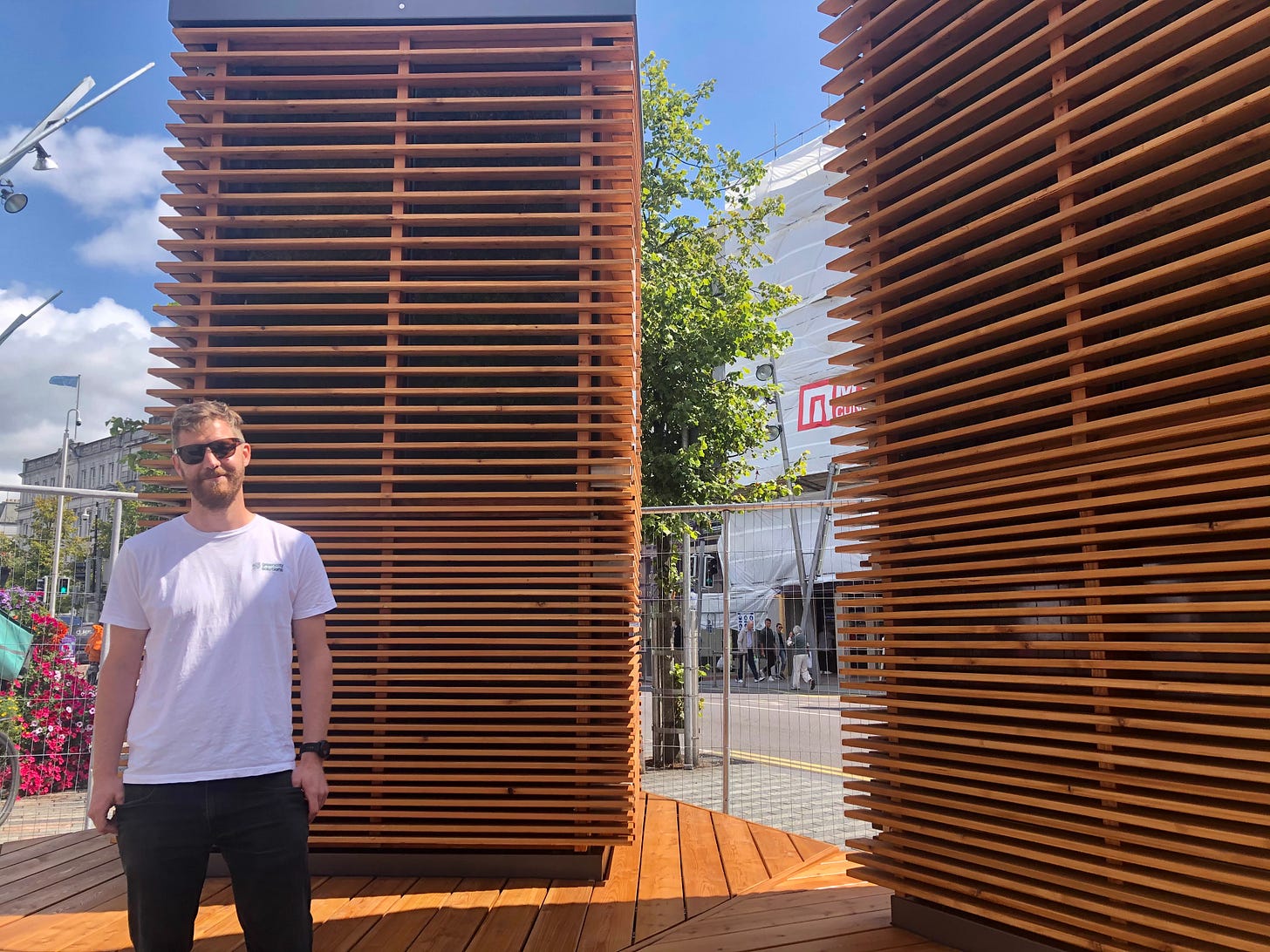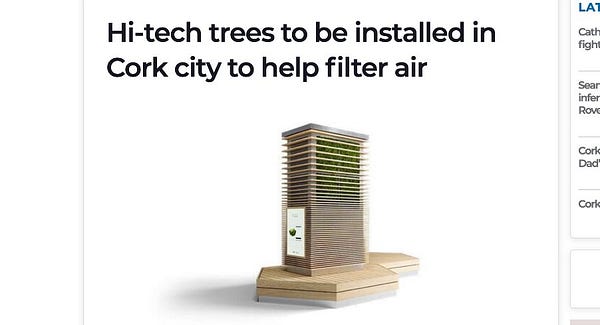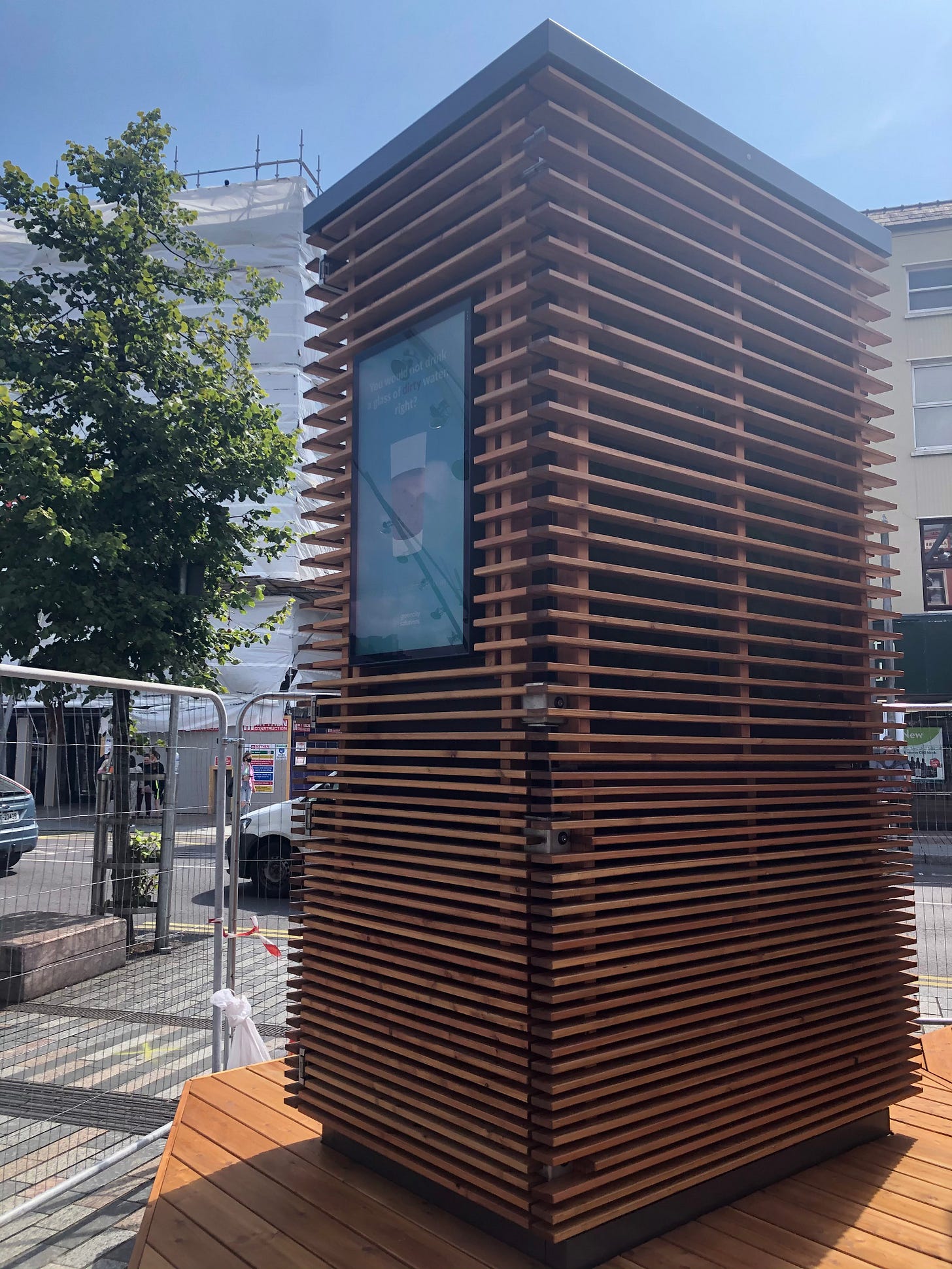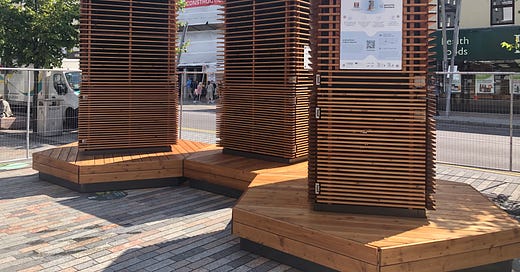Everything you wanted to know about Cork's new Robo-trees but were afraid to ask
Cork City Council has installed five moss-filled "CityTrees" to filter and cool air and to gather data on air quality in the city centre, at a cost of €350,000.
The appearance of five high-tech moss walls known as CityTrees in Cork City Centre has stirred up a lot of debate, conversation and criticism during their installation this week.
They’ll have their official unveiling on Thursday morning, when Lord Mayor Colm Kelleher will also launch Cork City Council's Air Quality Strategy.
But so many questions were being raised by members of the public on social media that we talked to David Joyce, Cork City Council’s operations director, and Simon Dierks, the marketing lead for Green City Solutions, the Berlin-based manufacturers of the CityTree, to answer as many of these questions as possible.
It goes without saying that this was a day’s work for the T + D team. If you like what we do, please subscribe for just €8 per month, or if you can’t afford that, please share our articles widely and help us spread the word about our independent, totally reader-funded journalism project.
What are CityTrees?
They are a wooden structure containing a “moss wall” - moss has remarkable abilities to filter and cool air. As well as a moss wall, each CityTree is equipped with a large array of high-tech sensors and controllers to monitor the condition of the moss; see more in “How do they work,” below.
Cork City Council has purchased five and is putting them in two city centre locations: Patrick’s Street and Grand Parade.
Each location has one “premium” CityTree, which is the one with all the sensors and the 40-inch screen on it, with two more on Patrick’s Street and one more on Grand Parade.
How do they work?
Living Hypnum moss grown on a farm in Germany is suspended vertically on fibrous mats behind the wooden laths on the structure.
Integrated fans actively propel the surrounding air towards the moss surface, where it captures dust particles from the air.
An electronic controller unit in each CityTree checks temperature and humidity levels and controls an irrigation pump to water the moss: rainwater gathers in the tank at the base inside the seating area and is pumped up onto the moss as sensors dictate.
The CityTrees in Cork are not solar powered: they are wired into a nearby electrical junction and operate from the grid. Each one requires “about the power of five lightbulbs,” or 125W, to power.
A CityTree can cool air by 4 degrees and filters out different particle sizes with varying degrees of efficiency: they work best on larger particles.
“The smaller the particles, the harder it is for the moss to bind them,” Simon Dierks of Green City Solutions, the manufacturers, explains. “Larger PM10 particles are filtered out almost 100%, PM2.5s are filtered out 60% on average, and ultrafine particles are harder: the moss removes about 30% of them.”
The distance at which they are effective varies depending on weather conditions, but their impacts are localised.

Who makes CityTrees?
Green City Solutions (GCS) are a German start-up based outside Berlin, employing 35 people. They launched their first iteration of the CityTree, a passive filtration system, in 2016.
Having been widely hyped, the first CityTrees weren’t a roaring success: some are still present in European cities (there’s a map here) but GCS are working to replace these with their latest model.
“In 2018, we did a €2 million development project funded by the EU and the goal was to shift from passive to active filtration,” Simon Dierks explained. “This was finished in 2019.”
Some reports of the CityTree’s efficacy that are available online are referring to this earlier model, Mr Dierks was quick to point out.
“I think it’s natural for start-ups to make mistakes, and we made mistakes and we learned from them,” he said. “It’s more than fair to be critical, but it’s not fair to criticise the first generation product and compare it to the new, improved one, because we’ve made a lot of effort in solving all the problems of the first generation.”
The company operates a transparent policy and welcomes questions: on the last Monday of every month, GCS hold a virtual tour of their moss farm open to all, and questions can be asked at that.
How much did Cork’s CityTrees cost?
Although original reports dating back to last year, including a long read on Tripe + Drisheen, contained the council’s estimate that they would cost €380,000 for four, the final cost has been €350,000 for five.
The bill covers the cost of purchase, shipping, installation and the first year of management.
“After the first year, the management and maintenance per annum is a couple of thousand,” David Joyce, Operations Director with Cork City Council, told Tripe + Drisheen.
Did Cork City Council pay for them?
No. The full €350,000 bill is footed by the National Transport Authority, from a €55 million fund announced as part of last July’s Covid-19 stimulus package. Cork City Council applied for the project fund specifically for the purchase of these CityTrees.
“This is a project fund we applied for,” David Joyce said. “If we hadn’t applied for it we would have received nothing. We identified an innovative project that fits in with our long-term strategies around air quality. This is not local funding that could have been spent on something else and it’s not removing funding for other projects.”

What independent scientific studies did Cork City Council review before purchasing the CityTrees?
Cork City Council relied on only one report, provided by GSC’s own “scientific partners” at Leibniz Institute for Tropospheric Research, for evidence of their efficacy.
“We reviewed the published German university evaluation of the CityTrees before purchasing them,” Mr Joyce said. “I don’t know how the university was commissioned to undertake the evaluation project. It may have been commissioned by the EU to validate their project, or by Green City Solutions themselves.”


Does one CityTree do “the work” of 275 real trees?
No. Press reports on the CityTree mark one focused on this comparison but the company now want to move away from trying to compare the function of the CityTrees to that of real, living trees.
Partly this is because CityTrees mainly function by capturing particulate matter from the air, as described above, rather than primarily converting carbon dioxide into oxygen, as trees do.
“This number of 275 trees is four or five years old, but the internet never forgets,” Mr Dierks said with a wry smile. “That number is not true, and it’s not smart to say, because we don’t want to compete with trees. Before we realise projects, we want to ensure that actual tree-planting is part of the strategy. They turn CO2 into oxygen, they have shadowing effects and are home to birds and animals. The CityTree can’t do the same things, but it can measure data, cool the air up to four degrees and we bind fine dust with immediate effect.”
The comparison to living trees has been a bad PR move for the company, Mr Dierks said.
“I wasn’t the marketing lead when the decision was made to call the product CityTree and I would not do that again,” he said. “It’s a good name, but I think it evokes a concern of trees being cut down and in the future just having CityTrees everywhere. We don’t see ourselves as the next evolutionary step for trees. We love trees.”
He believes that the Cork response to the project as evinced on social media, which he describes as “overwhelming in how harsh it has been,” is partly due to this misconception that CityTrees are a form of tree substitute.
Do we need CityTrees?
According to a study from 2018, 8.9 million deaths could be attributable to exposure to outdoor fine particulate matter.
The Environmental Protection Agency (EPA) says that as many as 1,300 avoidable deaths are due to air quality in Ireland each year.
Cork City Council is in the vanguard in Ireland in deploying a network of inexpensive air quality sensors. Together with UCC’s Centre for Research into Atmospheric Chemistry the council have 14 air sensors spread across the city which take regular PM measurements. (The EPA has four regulatory monitoring sites in the city).
As Dean Venables, a lecturer in physical and environmental chemistry in the School of Chemistry and Environmental Research Institute at UCC, notes in his research paper, air quality in Ireland is “mostly good.” The founders of Green City Solutions were inspired by the heat and dust of large Asian cities they visited while travelling. Certainly the “pleasant cooling” function of the moss walls is unlikely to bring benefits to Corkonians for most of the year.
As Mr Venables also noted, prevention is better than cure when it comes to air quality: it’s much harder to try to remove particulate matter from air than is to prevent it. His research, based on the 14 air sensors and linked above, demonstrates that in Cork, poor air quality is most notable on winter evenings when solid fuels are being burned, and is most likely to occur in traditionally disadvantaged areas of the city.
So why aren’t the City Trees in Ballyphehane?
As Simon Dierks points out, because of the localised impact of the moss walls, it makes sense to locate City Trees where people congregate.
“These fresh air zones must be where a lot of people come together every day, whether that’s a shopping street or somewhere people work every day,” Mr Dierks said. “We have two CityTrees in a schoolyard in London, and that’s a good example because the children have to be there and so they’re stuck in a place with bad air quality.”



Are they value for money? Could you get 10,000 real trees for the same price?
Many complaints from the public indicate that people don’t think Cork City Council should have forked out €350,000 for these.
As several commentators have noted, a lot of actual trees could have been purchased for €350,000.
Mr Dierks, of course, believes the GCS offering is good value.
“There are several benefits: improvement of air quality, a city bench in pleasant air, a communication tool,” he said. “People think trees cost nothing, but you can’t plant 10,000 trees for the price of these: that might be how much the young trees would cost but trees need maintenance too, so I think that’s a very unfair comparison. We are an innovative technology with a lot of benefits and I think we are worth the price.”
Mr Joyce echoed the opinion that the comparison with real tree purchase is unfair. “If you take a look at Grand Parade, for example, where are you going to put those saplings?” he said. “You’d have to dig up significant quantities of the city centre. Taking the purchase price of a sapling without the cost of installing (we believe he means planting) and maintaining them, and comparing that to the purchase, shipping, installation and maintenance of the CityTrees is unfair.”
Are City Trees more of a public awareness campaign, or positive PR for Cork City Council?
One argument in support of the CityTrees is that by displaying real time data about air quality we can all be better informed and educated about air quality. Green Party Councillor Oliver Moran requested back in October 2020, when it was announced the City Council had secured the CityTrees, that “their installation would be accompanied by a public monitoring/scientific element.”
The reply Oliver got from David Joyce was “an array of sensors would be used to analyse the air quality from the Moss Wall.”
CityTrees function as a “conversation starter” on air quality, according to Simon Dierks.
But whether this all amounts to a positive marketing campaign for Cork City Council as opposed to ongoing information of public benefit is unclear.

The built-in 40 inch display screens on each “premium” tree is designed to share information on air quality, but can also be used for other information. Cork City Council plan to use the screens to promote public messaging about their own initiatives.
“Cork City Council will use them to communicate with the public on more than just air quality,” David Joyce said. “They will be used to let the public know what Cork City Council is doing. They also provide seating for up to 75 people. Why use a site for just one use when it can be put to multiple uses, isn’t that better value for money?”
Will they be used for advertising?
Mr Joyce said the council had “no plans at this point in time” to sell advertising space to third parties on the screens.
Is my data also being harvested?
Green City Solutions have assured Tripe + Drisheen that CityTrees do not come with cameras or facial recognition tools and only gather data on air quality.
Will they get vandalised?
Cork City Council don’t have any preventative measures to stop this from happening.
“There’s no way of stopping anything from getting vandalised, obviously,” Mr Joyce said. “We’re hoping people will respect the CityTrees, but obviously we will deal with that if it happens and repair them if necessary.”


How is the environmental cost of producing such high-tech structures offset against their benefits?
A full, conclusive Life Cycle Analysis (LCA) for CityTree is not currently available, so Cork City Council have not accessed this information. Mr Dierks says an LCA is currently being finalised, and that GCS focus on tree-planting to replace the German timber they use to construct the exterior of the machine and to offset the carbon costs of all the other materials and components.
“We need to exclude the screen because we get the screen from a partner, but every other material is bought from regional partners to cut down on distance,” he said.
“We get wood from the next state, and for every tree which is cut, we plant two trees. We’re working on the footprint calculation and the results will be there soon, but it’s not finished. We take care to have the lowest possible footprint in every step and every area where the carbon emissions are above zero, we take care of the emissions in other areas because it’s very important to us to be CO2 neutral in the end.”
Isn’t prevention better than cure when it comes to air pollution?
Yes. See Dean Venables’ thread above. Many commentators pointed out that enforcing the Pana car ban, promoting active transport and lessening the burning of solid fuels for heat would all reduce airborne particles.
GCS say they are not trying to cure air pollution: “We see ourselves as one piece of the puzzle, part of a broader strategy. We know we can’t solve air pollution and that’s not our approach,” Mr Dierks said.
David Joyce echoed this point: Cork City Council’s full Air Quality Strategy will be announced on Thursday and will comprise more than just the CityTrees.
What about real trees?
Independent councillor Lorna Bogue told Tripe+Drisheen the priority should be to plant more trees in the city. By example, Bogue pointed to the idea outlined by Cork-based architect Kevin Smyth from 2019 to plant a continuous line of trees along the north and south banks of both channels of the River Lee as it flows through the city.
“You look at Glasgow and for COP26 they’re planting 18 million trees. That’s where we need to be going,” she said. That’s ten trees for every person in Glasgow to be planted over the next decade.
As Ms Bogue also pointed out, another benefit with real trees is that they add to biodiversity: trees support insect, plant and bird life.
“I don’t know, it’s not something that’s going to get through this current council,” she said. “A lot of them just dislike trees.”
And finally….what about that Trees Officer?
Working within the City Council’s Parks and Recreation team, the long-awaited Trees Officer will be responsible for developing a tree strategy for the city as well as coordinating the city tree survey. The role comes with a salary of between €50,000 - €70,000.
Interviews were held earlier this summer and an announcement on the appointment is imminent. Tripe+Drisheen were told this week that that would be in late September, however Green Party Councillor Dan Boyle writing on Twitter said the person would start as soon as next week.
Trees on the T+D archives:







Interesting, glad of more information